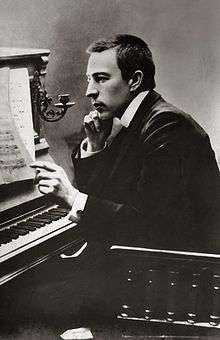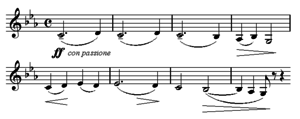Piano Concerto No. 2 (Rachmaninoff)
The Piano Concerto No. 2 in C minor, Op. 18, is a concerto for piano and orchestra composed by Sergei Rachmaninoff between the autumn of 1900 and April 1901.[1] The second and third movements were first performed with the composer as soloist on 2 December 1900.[2] The complete work was premiered, again with the composer as soloist, on 9 November 1901,[2] with his cousin Alexander Siloti conducting.
This piece is one of Rachmaninoff's most enduringly popular pieces,[3] and established his fame as a concerto composer.[4]

Background
At its 1897 premiere, Rachmaninoff's first symphony, though now considered a significant achievement, was derided by contemporary critics.[5] Compounded by problems in his personal life, Rachmaninoff fell into a depression that lasted for several years. His second piano concerto confirmed his recovery from clinical depression and writer's block, cured only by a course of hypnotherapy. The concerto was dedicated to Nikolai Dahl, a physician who had done much to restore Rachmaninoff's self-confidence.[5]
Composition
The work is scored for 2 flutes, 2 oboes, 2 clarinets in B♭ (I mov.) and A (II & III mov.), 2 bassoons, 4 horns in F, 2 trumpets in B♭, 3 trombones (2 tenor, 1 bass), tuba, timpani, bass drum, cymbals, solo piano, and strings. It is written in three-movement concerto form.
Moderato: C minor
.jpg)

The opening movement begins with a series of bell-like tollings on the piano that build tension, eventually climaxing in the introduction of the main theme. In this first section, the orchestra carries the Russian-character melody while the piano makes an accompaniment made of rapid oscillating arpeggios. After the statement of the long first theme, a quicker transition follows until the lyrical second theme, in E flat major, is presented.
The agitated and unstable development borrows motives from both themes changing keys very often and giving the melody to different instruments while a new musical idea is slowly formed. The music builds in a gradual climax as if the first bars were to be repeated, but in the recapitulation the theme is presented as unique to the first statement.
While the orchestra restates the first theme, the piano, that in the other occasion had an accompaniment role, now plays the march-like theme that had been halfly presented in the development, thus making a considerable readjustment in the exposition, as the main theme, played by the orchestra has become an accompaniment. This is followed by a piano solo, which leads into a descending chromatic passage. Then there is a horn solo, where the second theme is heard in A flat major. From here the last minutes of the movement are placid until drawn into the agitated coda, and the movement ends in C minor fortissimo.
Adagio sostenuto – Più animato – Tempo I: C minor → E major
The second movement opens with a series of slow chords in the strings which modulate from the C minor of the previous movement to the E major of this movement. The piano enters, playing a simple arpeggiated figure. This opening piano figure was composed in 1891 as the opening of the Romance from Two Pieces For Six Hands. The main theme is initially introduced by the flute, before being developed by an extensive clarinet solo. The motif is passed between the piano and other soloists before the music accelerates to a short climax centred on the piano. The original theme is repeated, and the music appears to die away, finishing with just the soloist in E major.
Allegro scherzando: E major → C minor → C major
The last movement opens with a short orchestral introduction that modulates from E (the key of the previous movement) to C minor, before a piano solo leads to the statement of the agitated first theme. After the original fast tempo and musical drama ends, a lyrical theme is introduced by the oboe and violas. This second theme maintains the motif of the first movement's second theme. After a long period of development tension is built up considerably. Near the end, Rachmaninoff restates the second theme in loud, fortissimo orchestration. After this a fast, ecstatic and very triumphant coda draws the piece to a close, ending in C major.
Derivative works
 |
ii. Adagio sostenuto
Performed by the Skidmore College Orchestra. Courtesy of Musopen. iii. Allegro scherzando (13 minutes)
Performed by the Skidmore College Orchestra. Courtesy of Musopen. |
| Problems playing these files? See media help. | |
The second theme of Allegro scherzando provides the basis for Frank Sinatra's 1945 "Full Moon and Empty Arms".[6]
The Adagio sostenuto theme appears in Eric Carmen's 1975 ballad "All by Myself". Carmen first composed the song's interlude, then took the bridge from Rachmaninoff and the chorus from his own "Let's Pretend". Carmen explained that Rachmaninoff was his "favorite music".[7]
The Moderato theme appears in Muse's 2001 song "Space Dementia". The lyric line "And tear us apart and make us meaningless again" follows exactly Rachmaninoff's melody in the first movement, which is first played by string instruments in the beginning of the movement, and then again by the piano toward the movement's finale.[8][9][10] The 1941 Sinatra song "I Think of You" is also based on the Rachmaninoff first movement.[11]
Popular culture
- In the 1932 film adaptation of Grand Hotel by Edmund Goulding with Greta Garbo
- In the beginning of the fourth act of Ayn Rand's 1943 novel The Fountainhead, Rachmaninoff's second concerto is cited as one of two musical works capable of acting as a surrogate for man's achievement.
- The concerto features significantly in David Lean's 1945 film Brief Encounter.
- It is the main theme of Frank Borzage's 1946 film I've Always Loved You. It is featured throughout the film in a soundtrack by Arthur Rubinstein.
- It features significantly in William Dieterle's 1950 film September Affair. In some moments the main theme of the first movement is mixed with Kurt Weill's "September Song".
- It was significant in the film Rhapsody (1954), directed by Charles Vidor, as the performance piece for a budding virtuoso pianist, James Guest (actor John Ericson in that role). The film starred Elizabeth Taylor and Vittorio Gassman.[12]
- It was used in Billy Wilder's 1955 film The Seven Year Itch.
- It features briefly in a 1956 Soviet film Spring on a Street Across the River (Весна на Заречной улице) in a radio broadcast performed by Lev Oborin.[13]
- It is briefly heard in George Roy Hill's 1964 film The World of Henry Orient.
- American actress Lauren Bacall selects this as her second disc on the BBC Program Desert Island Discs, 1978.
- It features prominently both during the fictitious American Ballet Academy's rehearsals and final ballet workshop performance in the 2000 film Center Stage.
- In the 2005 Korean movie Blood Rain, briefly towards the end right after the scene where the sky rained blood, and right at the end of the movie from the closing scene into the closing credits.
- It features in For Horowitz 호로비츠를 위하여 (2006), before the encore "Träumerei" in the end.
- It features significantly in both the Japanese anime (2007) and award-winning TV versions (2008) of Nodame Cantabile.
- It features prominently in Clint Eastwood's 2010 film Hereafter.
- It is frequently used in figure skating programmes, used by single skaters Midori Ito, Sasha Cohen, and Mao Asada, and ice dancers Meryl Davis and Charlie White, respectively, among others.
- It was used in 2012 by Russian rhythmic gymnast Daria Dmitrieva for her hoop routine; she was silver medalist at the 2012 London Summer Olympic Games.
- It features throughout the second episode of Series 1 of BBC Two's Inside No. 9, "A Quiet Night In".
- In the anime Fairy Tail it is often used as a theme.
- The first piano solo in the first movement is played by Lang Lang in "Dream", a collaboration between him and Jay Chou.
- In the anime Gankutsuou, the character Eugénie is shown practicing and performing it in episodes 11 and 12.
References
- ↑ Harrison, Max (2006). Rachmaninoff: Life, Works, Recordings. London: Continuum. pp. 92–99. ISBN 0-8264-9312-2.
- 1 2 "Rachmaninoff's Works for Piano and Orchestra". Classy Classical. 7 September 2005. Retrieved 27 February 2011.
- ↑ "Brief Encounter theme is UK's top classic". The Guardian. 29 March 2005. Retrieved 27 February 2011.
- ↑ Norris, Geoffrey (1993). The Master Musicians: Rachmaninoff. New York City: Schirmer Books. pp. 113–115. ISBN 0-02-870685-4.
- 1 2 Steinberg, Michael (1998). The Concerto. Oxford University Press. p. 357–358. ISBN 0-19-513931-3.
- ↑ "Full Moon and Empty Arms". Time. 23 June 1947.
- ↑ "An Interview with Eric Carmen Conducted by Gordon Pogoda in 1991", ericcarmen.com, retrieved 21 September 2010
- ↑ Muse's Space Dementia vs. Rachmaninoff's Piano Concerto No. 2, 10 March 2014
- ↑ Muse's Space Dementia sample of Sergei Rachmaninoff's Piano Concerto in C Minor, Opus 18, 1st Movement, WhoSampled
- ↑ Muse and Russian Composers: Space Dementia-2nd Piano Concerto by Rachmaninoff, Moderato, 18 April 2010
- ↑ Randolph, Marvin (17 December 2000). "'I Think Of You' Is Based On A Rachmaninoff Concerto". South Florida Sun-Sentinel.
- ↑ Rhapsody (1954) at the Internet Movie Database
- ↑ Весна на Заречной улице [Spring on a Street Across the River]. kino-teatr.ru (in Russian).
Sources
- Schirmer, G (1996). Tchaikovsky's Piano Concerto No. 1; Rachmaninoff's Piano Concerto No. 2 (Orchestra reduction for second piano). Mineola, New York: Dover Publications. pp. 101–163. ISBN 0-486-29114-6.
- Yungkans, Jonathan (14 March 2001). "The Second Piano Concerto". The Flying Inkpot. Retrieved 15 October 2007.
- Kuenning, Geoff (2000). "Rachmaninoff: Piano Concerto No. 2 in C Minor". Symphony of the Canyons. Retrieved 15 October 2007.
Further reading
- Anderson, W. R. (1947), Rachmaninov and his pianoforte concertos: A brief sketch of the composer and his style, London: Hinrichsen Edition Limited, pp. 9–14
- Chung, So-Ham Kim (1988), An analysis of Rachmaninoff's Concerto No. 2 in C Minor opus 18: Aids towards performance (Dissertation), The Ohio State University, retrieved 4 August 2010
- Coolidge, Richard (August 1979), "Architectonic Technique and Innovation in the Rakhmaninov Piano Concertos", The Music Review, 40 (3): 188–193
- Culshaw, John (1950), Rachmaninov: The Man and His Music, New York: Oxford University Press, pp. 78–84
- Evans, Edwin, ed. (1942), Serge Rachmaninoff's Piano Concerto No. 2, Opus 18: Analysis, New York: Boosey & Hawkes
- Slenczynska, Ruth (October 1973), "The Performer's Corner: The Opening of the Rachmaninoff Second Concerto", Clavier, 12 (7): 18
- Tsukkerman, Viktor (1965), "Zhemchuzhina Russkoy Liriki (Pearls of Russian Lyricism)", Sovetskaya Muzika (in Russian) (1): 25–35
- Veinus, Abraham (1945), The Concerto, Garden City, New York: Doubleday, Doran and Company, Inc., p. 248
External links
- Piano Concerto No. 2: Scores at the International Music Score Library Project
- Free sheet music of Rachmaninoff's Piano Concerto No. 2 from Cantorion.org